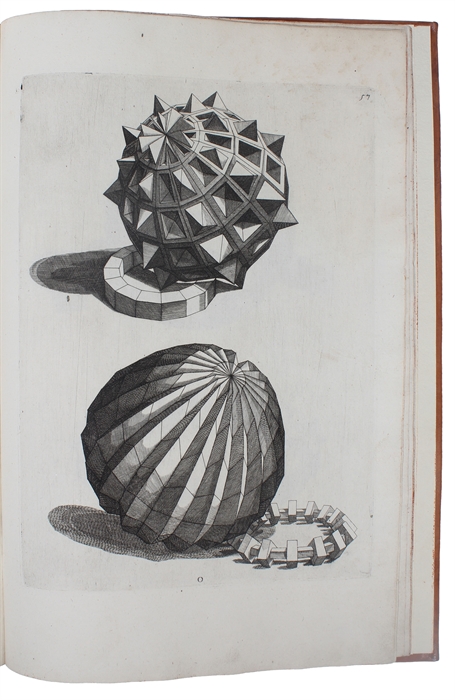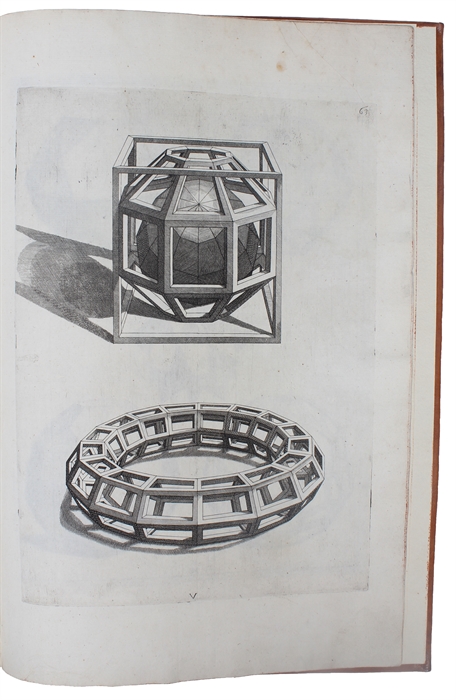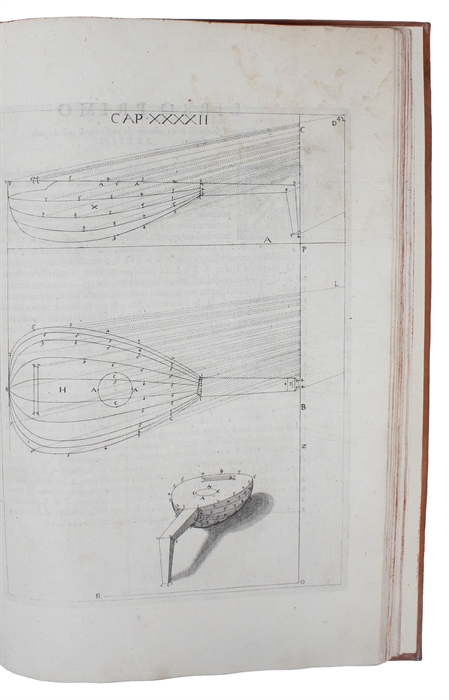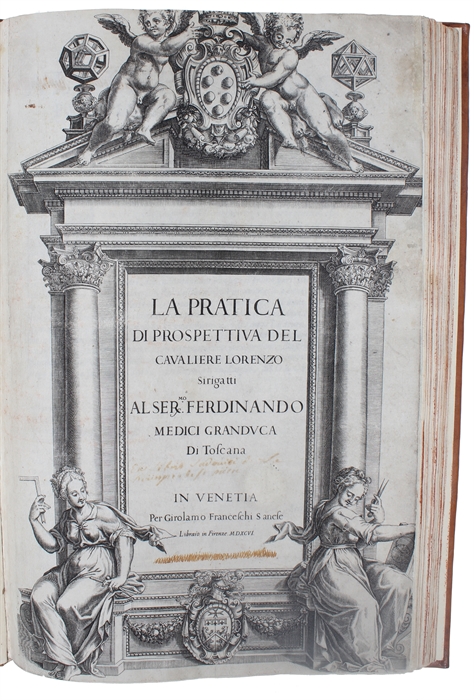FUNDAMENTAL WORK ON PERSPECTIVE
SIRIGATTI, LORENZO.
La pratica di prospettiva. 2 parts.
Venice, Girolamo Franceschi, 1596.
Folio (400x260 mm). Two parts bound in one later (presumably 19th century) sprinkled full calf with blindstamped geometrical ornamentations to boards. Leather on back board renewed. Engraved title-page neatly restored at inner margin, far from affecting imprint; old owner's inscription (""Ex libris Ludovici A. la..."), crossed-out previous owner's name, and traces after a stamp to title-page. With Medici arms at the top and those of Sirigatti at foot of title-page, repeated on title-page of part two. As with all other copies we have been able to locate, the title-page is trimmed, affecting approximately 1 cm of the allegorical depictions in margin. Large woodcut printer's device at the end of the volume. Light occassional discolouring, but overall in very fine condition.
1 f. (allegorical frontispiece), 3 ff. (of dedication and index), 43 plates numbered with parallel text, 1 f. (large woodcut printer's device), 22 copper engraved plates (including the title-page of the second part) numbered 44-65. I.e. 65 plates in total - fully complete.
The rare first edition of this most important work on the art of perspective: "Questa e la più elegante delle edizioni di libri prospettici per i tipi, pei caratteri, per la carta" (Cicognara 860). Sirigatti's work is famous for being one of the very earliest thorough works solely dedicated to the art of perspective. Combining the visual language of the German book tradition of Lencker and Jamnitzer with the Italian tradition of linear perspective treated previously by Serlio and Barbaro and earlier that of Leon Battista Alberti (unillustrated), as applied to stage design and architectural theory, this is one of the seminal Italian works on the subject of perspective. Presumably this work functioned as basis for Galileo’s drawing technique. The book quickly became very popular and several Italian editions were reprinted in the 17th century; its reputation was so long-lived that an English translation was published no less than 160 years after the original.
The work is divided in two parts: The first part is dedicated to the elementary rules of perspective to plane and solid geometric figures (which also contain musical instruments like the lute (plate 41 and 42)). The second part depicts architectural elements, facades of palaces and churches, in polyhedrons of various forms and regular Platonic solids, with several references to Luca Pacioli's "divina proportione". Furthermore, Sirigatti famously contributed to the study of theatrical perspective:
"He is the first to mention that the full effect of the perspective frame, for instance in a stage set, can be enjoyed only by those sitting along the main axis. This is a fundamental aspect of absolutist theater that no doubt had been noticed by designers of princely entertainments earlier, but is first commented on in print by Sirigatti, whose observations were taken up more extansively by Pietro Accolti." (Millard).
Two problems were endemic in perspective designs. First, because perspective scenery exploits the difficulty of the eyes in judging the sizes and distances of objects, it works best by assigning the spectator to a single point of vision and manipulating relative magnitudes to make small images represent objects that are larger and farther away. Second, the apparent magnitude and distance of painted objects tended to clash with the fixed size of live actors when applied to the theater, threatening to produce absurd combinations of scale when performers wandered upstage. Sirigatti was first to "acknowledge the problem of spectator position. Sirigatti proposed a way to combine a painted perspective backdrop with fixed three-dimensional scenery that diminished in size as it neared an upstage vanishing point". (Camp, The First Frame).
Sirigatti was not only influential in the theory of architecture and stage design. "Galileo "most certainly studied" La pratica di prospettiva, which was published in Venice while Galileo was teaching nearbyby in Padova, and that when Galileo and Thomas Harriot simultaneously pioneered the use of the telescope to study the moon's surface, it was Galileo's training in chiaroscuro that led him to see mountains and craters where Harriot only saw "strange spottedness"." (The Partnership of Art and Science: The Moon of Cigoli and Galileo).
Sirigatti was a member of the Academy of Drawing (Accademia del Disegno), a school for artists and engineers (where Galileo studied as a young man). Any young artist or mathematician working his way through Sirigatti and learning to create the spikes on a ring diagram such as this would master perspective and the handling of light and shadow (chiaroscuro). Each spike must cast an appropriate shadow, not unlike the patches Galileo would later discern through his "perspective tube" and interpret as the shadows of mountains protruding up from the surface of the Moon.
Adams S-1224
Cicognara 860
Fowler 336
Graesse VI,417
Macclesfield 1896
Mortimer 479
Millard 129 (the 1625-edition)
Order-nr.: 52658





